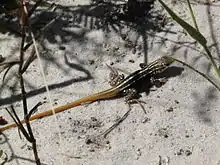Heliobolus
Heliobolus is a genus of lizards of the family Lacertidae. The genus is endemic to Africa.[1]
| Heliobolus | |
|---|---|
 | |
| Heliobolus lugubris | |
| Scientific classification | |
| Kingdom: | Animalia |
| Phylum: | Chordata |
| Class: | Reptilia |
| Order: | Squamata |
| Family: | Lacertidae |
| Genus: | Heliobolus Fitzinger, 1843 |
| Type species | |
| Lacerta lugubris A. Smith, 1838 | |
Species
There are four recognized species:[1][2]
- Heliobolus lugubris (A. Smith, 1838) – bushveld lizard, mourning racerunner, black and yellow sand lizard
- Heliobolus neumanni (Tornier, 1905) – Neumann's sand lizard
- Heliobolus nitidus (Günther, 1872) – glittering sand lizard
- Heliobolus spekii (Günther, 1872) – Speke's sand lizard
Nota bene: A binomial authority in parentheses indicates that the species was originally described in a genus other than Heliobolus.
References
- Heliobolus at the Reptarium.cz Reptile Database. Accessed 28 March 2020.
- Genus Heliobolus. The Taxonomicon.
Further reading
- Branch, Bill (2004). Field Guide to Snakes and other Reptiles of Southern Africa. Third Revised edition, Second impression. Sanibel Island, Florida: Ralph Curtis Books. 399 pp. ISBN 0-88359-042-5. (Genus Heliobolus, p. 161).
- Fitzinger L (1843). Systema Reptilium, Fasciculus Primus, Amblyglossae. Vienna: Braumüller & Seidel. 106 pp. + indices. (Heliobolus, new genus, p. 20). (in Latin).
This article is issued from Wikipedia. The text is licensed under Creative Commons - Attribution - Sharealike. Additional terms may apply for the media files.